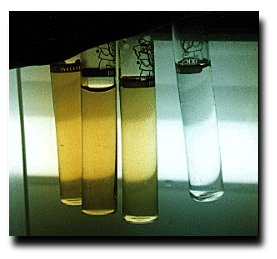
Yellow Water and Tannins
That yellow color in the water – by Erik Johnson DVM
“My pond is about 3 months old. The water is clear but has a yellowish tint that I would like to get rid of. I have koi and water plants in the pond. All my water tests are fine except the water seems to be ‘hard’ and the pH is about 8.5 in the afternoon. What could be causing the yellowish tint and what product do you have to correct it?”
There are at least three places “yellowing” can come from.
 If Ammonia accumulates sufficiently, it can cause a yellow cast to the water. Of course, this is easily tested – and not the most common cause of water-yellowing.
If Ammonia accumulates sufficiently, it can cause a yellow cast to the water. Of course, this is easily tested – and not the most common cause of water-yellowing.
Leaves which fall into the pond will decay and cause yellowing. This is the release of tannins – which are astringent for fish. They are NOT terminal, or deadly, but they represent deterioration of water quality which especially makes fish more vulnerable to disease organisms. Further, it is harder for fish to heal from ulcers and abrasions in tannin stained water.
The most common cause of yellowish casting of the water is plants and their pots, or bog gardens which share water with the main pond. This is the most common and the worst cause of yellowing in the water. Basically it’s a “tea” being made with your pondwater percolating in and around the dirty root ball of the plants. Soil tea.
SOME bogs are bad. Some are good. And all can be re-mediated and sustained by water changes. All ponds need water changes. The more fish and fish wastes, and sometimes, the better the filtration – the more important water changes become. I’ve been using 1/8th inch ID irrigation line to supply my various ponds and tanks with constant inflow of fresh water as a form of 10% per week all the time water change. I’ve written that up on this web site.
Anyway; not all bogs are bad. Some are crafted from gravel with an intentional and uniform “upflow” or “downflow” limnion and are well engineered for filtration. These gravel bogs may have abundant plant material PLANTED IN THE GRAVEL – not in root balls. I have several of these set up and I am ENTHRALLED with their performance. These plants are nitrate users. And on top of that, green cloud-algae cannot grow in tannin stained water. Humic / tannic acid are algae inhibitors.
Potted plants can leach tannins and other amber colored contaminants from their soil into the pond. Folks are highly recommended to repot their plants in large sized aggregate gravel, and replant the plants every year to minimize the development of anaerobic decay conditions in the pots. I am not a plant expert but i have seen some neglected plants become part of the problem, not the solution.
Water testing can rule out Ammonia.
If Tannins are incriminated, remove all leaf litter and take your bog gardens off line until they are cleaned up, which is sometimes on an annual schedule, you have to check with the pond eco system type and style.
Finally, a major water change will remove most of the yellow color.
If major water changes are not feasible, then you can use carbon to control the yellow color. Carbon is a black aggregate media which is made from superheating organic materials like coconut shell and wood as if in a kiln, except in the absence of oxygen. The product is black and light in weight.
After rinsing, the carbon can be put in a nylon mesh bag and placed directly in the water flow. It is NOT as effective to put the carbon in your waterfall because even though the water is moving rapidly, it’s not moving THROUGH the carbon bag. This takes some engineering. If you can get ALL your water through a pump in three hours, and that pump goes through a five gallon bucket half-full of carbon in mesh bags without channeling or bypass, you will see gin-clear water in two days. The idea is that ALL the water is PUSHED THROUGH the carbon. Not just over it.
Carbon expires rapidly, in direct proportion to the organics in the system. If the system has a lot of tannins – the carbon will expire on the order of days. After replacement, with cleaner water the next bags of carbon will last longer.
Unsure if the carbon still works? Simply take some and put it in a glass of water. Add a couple drops of Methylene Blue. Check it again in the morning. If the MB is gone, the carbon still has some “life” in it.
